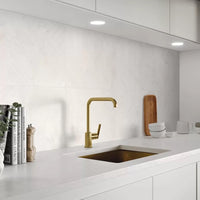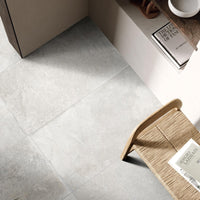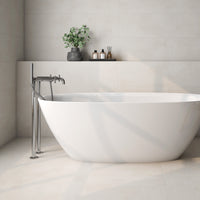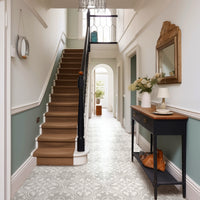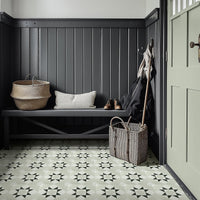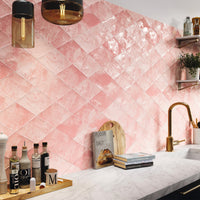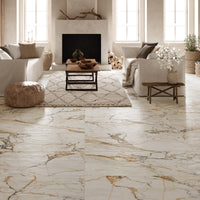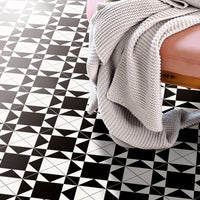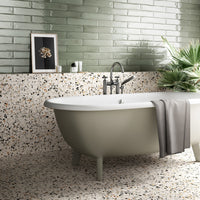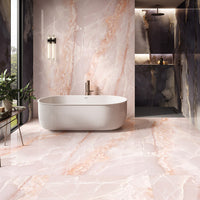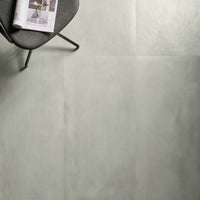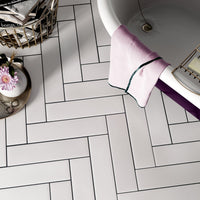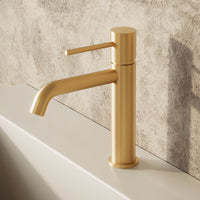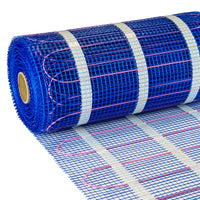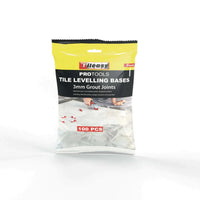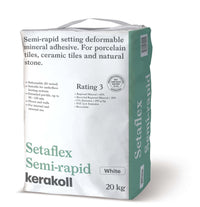
What springs to mind when you look at this picture?
For me, it’s the perfect blend of old meets new. A contemporary grey sofa with a battered reclaimed table. Vintage chairs sitting atop a timeless limestone floor. Undeniably, natural stone tiles are full of warmth and character and I’ll let you into a little secret… last year I tiled my wetroom in natural marble tiles.
“What?!” I hear you say. “This guy sells porcelain for a living yet uses natural stone in his own house?”
Yes. It was a bad idea.
Let me tell you why.
Every day I talk to our customers and explain to them how porcelain tiles are so easy to live with and look after. I wish I’d listened to my own advice. Rather than enjoy the rare event that is a sunny Manchester weekend, I spent half of Sunday on all fours, scrubbing down my marble tiles in a vain attempt to get them looking as pristine as the day they were laid.
I love stone, I really do. I love the warmth of travertine, the glamour of polished Carrara marble and the timeless simplcity of slate. Stone tiles look great in a high street shop, or a glossy catalogue… but not in my home.
They were a nightmare to install, need constant TLC and they cost a small fortune.
Step forward, porcelain
As they say, hindsight’s a wonderful thing. So looking back, with the lessons of the past year behind me, I should have used stone-effect porcelain tiles. Here’s what I should have told myself a year ago.
Stone-effect tiles look just like real stone
Not so long ago, if you bought a stone tile it was really nothing of the sort. You’d get a small rectangular piece of glossy ceramic, with a vein or two on. If you were lucky, the next tile might have a different pattern.
It’s pretty amazing how things have changed in a relatively short space of time. These days, if you go looking for a stone effect tile you’ll see pixel perfect copies of stones from around the world. The vast majority will have been produced using ‘inkjet technology’ which means they have a high definition print with very little repetition between individual tiles. Had I tiled my bathroom in marble-looking porcelain tiles I doubt anyone would have noticed the difference.
Porcelain tiles are just far less hassle
Few of us are fond of scrubbing floors and why waste all that elbow grease when porcelain tiles are so easy to live with? Unlike natural stone which is highly porous and liable to staining, porcelain is virtually impermeable.
This makes it very difficult for water, wine, or anything you can think of to seep in to the surface and stain the tile. Cleaning wise, a light mop with warm water will do the trick most of the time. And you can forget about sealing or using specialist cleaning products. The end result? More free time to sit outside and enjoy the sun.
And they’re far easier to install
Did I mention that I tiled my wetroom myself? Again, bad idea. Working with stone isn’t easy as I found out. Each and every cut has to be made using a messy ‘water cutter’, which spits out water and dust for fun. Once you’ve wiped the tile clean it has to be sealed before it goes up on the wall.
And then, just as it’s been installed, you realise that the grey vein running down the tile is actually a hairline crack… Or that the tile you installed before is actually a different thickness… So down comes the tile and the process starts all over again.
To cut porcelain your tiler can use a ‘dry cutter’ which takes just a few seconds and makes hardly any mess at all. It really is an easier and more enjoyable experience and it’s no wonder that many tilers charge a premium if they’re installing natural stone tiles.
Porcelain is far more affordable
OK, I know you can pick up cheap travertine tiles from here, there and everywhere but I wouldn’t touch these with a barge pole. It’s common knowledge in the tile world that these are ‘second choice’ which basically means steer well clear.
If you compare prices for good quality natural stone tiles you’ll see that these are far, far more expensive than our porcelain tiles. Two, three, sometimes four times as much. And this to me is strange. Our tiles are produced to the highest standards in world-leading Italian factories, often using recycled materials. And yet they’re so affordable. Stone is, and always has been, extremely expensive.
And can be used pretty much anywhere
I’m lucky that I used the marble tiles in my bathroom – had I laid them in my kitchen or hallways I’m pretty sure I’d be looking at pulling them all up and starting again. The higher footfall and pressure would have cracked or worn them down. Without being an expert in natural stone it’s pretty difficult to gauge whether a certain stone is suitable for a particular room.
However, porcelain tiles are far more durable and you can use any tile on pretty much any floor in your home. They have to meet certain standards for wear and abrasion so you can be sure you’re investing in a product that’s going to last.
Some manufacturers estimate their tiles can last for thousands of years so it’s safe to say that porcelain tiles are the wise choice for the long run! Unfortunately for me, I’ll have to stick with my wetroom for another few years but next time, I’ll be listening to some of my own advice.
Before I forget, those timeless limestone tiles in the picture at the top of this post? You guessed it… they’re actually limestone-effect porcelain tiles. Try spotting the difference!
